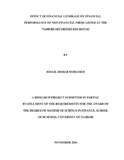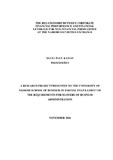| dc.description.abstract | Capital structure decision is among the key financial decisions that are taken by firms because financial leverage has an effect on the financial performance. Theoretical foundations on capital structure have found different conclusion where Modigliani and Miller argued on the irrelevance of debt on capital structure and agency theory to stress on the importance of debt in capital structure to control the actions of management. No agreement exists on the nature of the effect of financial leverage on financial performance from both the theoretical and different empirical studies. The aim of this study was to ascertain the effect of financial leverage on financial performance of non-financial firms quoted at the NSE. The population for the study was all the 40 non-financial firms listed at the NSE. However, out of the 40 non-financial firms, the researcher managed to get data for 39 companies amounting to 97.5% response rate. The independent variables for the study were financial leverage measured by the ratio of total debt to total assets, asset tangibility measured by the ratio of fixed assets to total assets, liquidity measured by current ratio and firm size measured by a log of total assets. Financial performance was the dependent variable and was measured by return on assets. Secondary data was collected over a five 5 year time frame (January 2013 to December 2017) annually. The descriptive cross-sectional research design was employed for the study. Data analysis was undertaken using the SPSS software. The relationship between variables established using multiple linear regression analysis. The study found that the independent variables had a correlation with financial performance of non-financial firms listed at the NSE (R=0.221). ANOVA results show that the F statistic was significant at 5% level with a p=0.049. Therefore the model was fit to explain the association between the selected variables. From the research findings financial leverage (t= -0.243, p= 0.808), firm size (t= -1.133, p= 0.259) and asset tangibility (t= -0.306, p= 0.760) produced a negative effect on the financial performance of listed non-financial firms’ in Kenya. Liquidity (t= 2.716, p= 0.007) had a positive and significant effect on the financial performance of listed non-financial firms’ in Kenya. This study recommends when firms are setting their capital structure they should strike a balance between the tax savings benefit of bankruptcy and debt costs associated with borrowing. The study also recommends that non-financial firms quoted at the NSE should maintain adequate levels of liquidity as the findings of this study depict a positive significant effect of firm liquidity on financial performance. | en_US |






